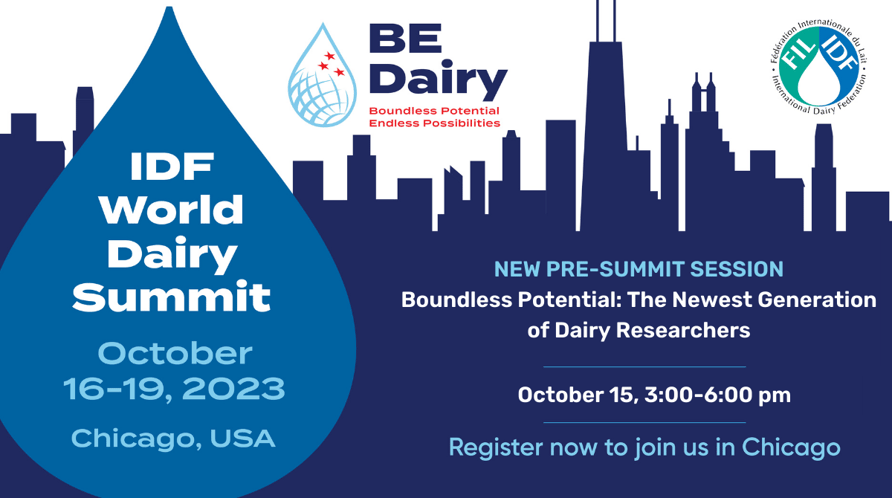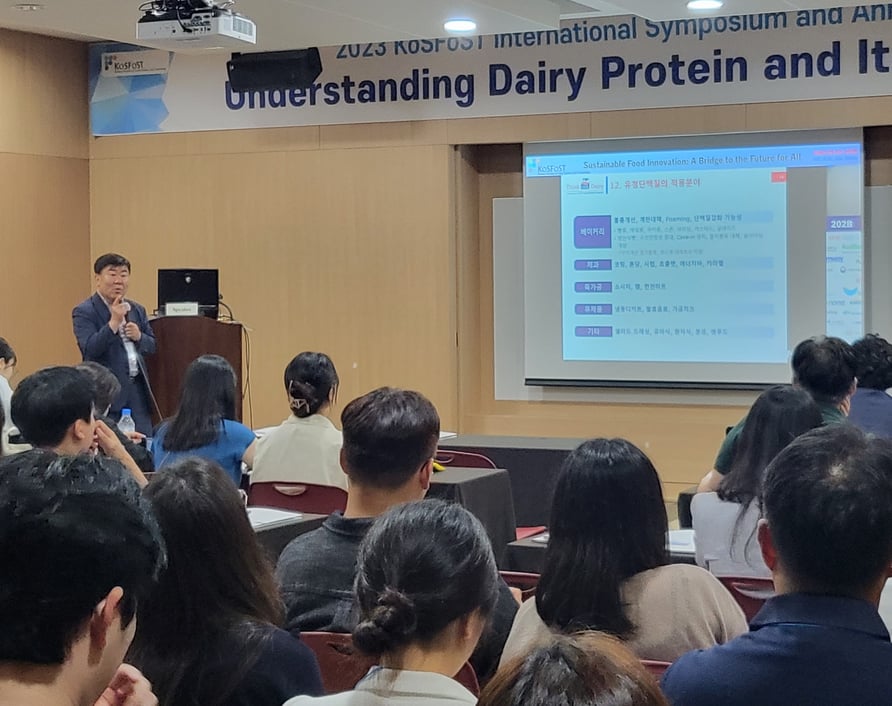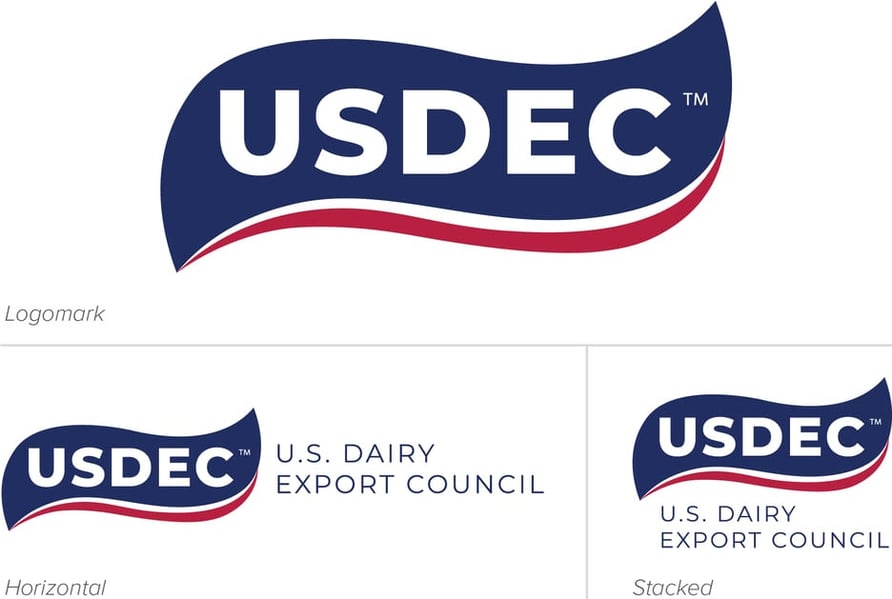HIGHLIGHTS: JULY 7, 2023
• Check out the IDF World Dairy Summit program
• Seeking member input: Canada to revise valuation calculations
• India delays health certificate implementation
• New research! How U.S. dairy stacks up to the competition
• Communicating U.S. dairy protein benefits in Korea
• Market Summary: May U.S. dairy exports slip 13%
• GDT down across the board
• Nearly 200 USDEC Export Guide reviews in June
• USDEC changes its logo
• NZ dairy processors struggle
Featured
Don't miss out on a world of dairy knowledge at the IDF World Dairy Summit
This year’s International Dairy Federation (IDF) World Dairy Summit, Oct. 16-19 in Chicago, is shaping up to be the can’t-miss dairy event of the year, bringing together dairy leaders, scientific experts, farmers and manufacturers from around the world and packed with presentations, events and networking opportunities.
The Summit features eight plenary sessions and more than 20 scientific and technical sessions, as well as social events and technical tours to several dairy farms, processing plants, a research center and laboratory—all nearby the Chicago area.
“The IDF World Dairy Summit is uniquely positioned as a truly global gathering intending to focus on the international dairy community and the most pressing issues impacting dairy farmers and processors all around the world, versus just in one corner of the globe,” says Shawna Morris, USDEC senior vice president, Trade Policy, and IDF WDS 2023 Co-chair.

The eight plenary sessions will cover topics ranging from dairy’s role in nourishing the world to dairy farming and processing trends around the globe. In the Global Leaders Forum plenary session, some of the world’s dairy trail-blazers will discuss how their organizations are employing new approaches to meeting today's challenges while also charting a path toward a prosperous future.
The more than 20 concurrent sessions include:
- Economic Outlook on Dairy Drivers and the Decade Ahead
- Upcycle Processing of Dairy Co-products—Closing the Loop
- Methods of Analysis: Microbiological
- Advanced Tools in Foodborne Pathogen Monitoring for the Dairy Industry
- Dairy’s Environmental Impacts: Reducing Pressure on Resources and Maximizing Eco-Systems Services
- Accelerating Profitable Sustainability for Dairy Farmers
- Food Systems Transformation Essentials: A Holistic Approach that Supports Human and Planetary Health
The full program—with summaries of all the plenary and concurrent sessions—can be viewed on the Summit website. Updates related to speaker confirmations will be shared over the next several weeks. The website also includes a link to register for the Summit as well as the pre-Summit session, “Boundless Potential: The Newest Generation of Dairy Researchers,” on Oct. 15 from 3:00-6:00 p.m.
October in Chicago is a very busy month for meetings and conferences, so we encourage you also make hotel reservations soon to receive the discounted rates at the IDF World Dairy Summit room block hotels, all of which are connected to the IDF Business Meetings/Summit venue.
Canada proposes to revise valuation calculations; member input welcomed
The Canada Border Services Agency (CBSA) recently launched a consultation on a proposed amendment to the valuation of imported shipments that specifically aims to modify how customs duties are assessed to non-resident importers (NRIs). The proposed modification would change the method for determining the value for duty (VFD) of imported goods.
Under the amended definition of “sold for export to Canada,” the relevant sale for calculating VFD is the “last sale.” This means that the declared VFD will be based on the “last sale” price of the transaction that causes the goods to be imported into Canada, as compared to the current method of assessing when title transfers, or whether the purchaser is a resident or maintains a permanent establishment.
Several industry analysts have said that this change could increase the customs duties paid in Canada, which could have ripple effects across the supply chain.
See the Member Alert of July 5 for a link to the proposed text and the CBSA Regulatory Impact Analysis Statement.
Interested companies may file comments directly with CBSA by July 26. Members may also send concerns to USDEC by July 19 for incorporation into USDEC’s comments. Please contact Sandra Benson at sbenson@usdec.org or Aimee Pinkerton at apinkerton@usdec.org for more information or with any questions.
India delays health certificate implementation
Reports from FAS and exporters indicate that India’s government has extended the implementation date of its new model health certificate until Dec. 31, 2023. The new certificate was previously scheduled to be enforced on May 30, 2023.
The impact of this announcement should mean that the status quo holds for now, and that the 2019 DAHD dairy certificate will be required until such time as the new integrated certificate is enforced. DAHD had previously allowed import of Chapter 35 whey proteins and Chapter 17 lactose for nutraceutical or pharmaceutical applications without a certificate if an importer provided a declaration that they were for non-food use.
At this stage, the U.S. government (USG) cannot endorse the DAHD model certificate or the new integrated health certificate, given the problematic nature of various attestations on them. USDEC continues to work with the USG to explore paths forward on the longstanding certificate impasse.
See USDEC’s Member Alert of July 6 and Volume 2 of the USDEC Export Guide for more information. Contact Sandra Benson at sbenson@usdec.org with questions.
New USDEC research explores how U.S. dairy is performing through the lens of current and prospective buyers
A new, members-only research report from the USDEC Strategic Insights team examines how U.S. dairy stacks up versus competition through the lens of current and prospective buyers in key export markets. The research included surveying 1,236 customers in markets including Japan, China, Southeast Asia, the Middle East/North Africa, Mexico and South America.
One overall learning is that to cultivate customer awareness and foster stronger relationships, U.S. dairy can establish itself as a reliable and dedicated supplier by meeting buyer requirements. This entails promptly addressing customer service inquiries, understanding local market demands, offering technical assistance, and providing a diverse, valuable and high-quality product portfolio.
Download the executive summary or full report here. The report provides market-specific opportunities based on the learnings from the study, which are tailored to address existing strengths and barriers in each market. For more details, please contact Strategic Insights at sidepartment@usdec.org.
Events
USDEC highlights U.S. dairy protein applications at KoSFoST
Explaining and demonstrating how U.S. dairy proteins fit the specific needs of consumers in key target markets is a cornerstone of USDEC’s ingredients marketing program. USDEC took those efforts to South Korea late last month at the Korean Society of Food Science and Technology (KoSFoST) conference in Jeju.
KoSFoST is a voluntary, nonprofit scientific association that advances knowledge and disseminates scientific and technical information and training to the food industry while also fostering innovation. The conference, themed “Sustainable Food Innovation: A Bridge to the Future for All,” included technical and educational sessions on a range of important topics for the Korean and global food industries. More than 3,100 food industry professionals, students and government representatives attended.
USDEC sponsored one of the concurrent breakout sessions on June 29 called “Understanding Dairy Protein and its Applications.” It was USDEC’s first participation in a KoSFoST event and also the first in-person business-to-business trade engagement activity in Korea since before the pandemic.
The event comes at a time of rising demand for higher protein foods and beverages in Korea as consumer attitudes are shifting. Once seen as a nutrient geared specifically to sports nutrition, protein fortification is moving into mainstream foods and beverages.

Bakery specialist Young Gwan Lee from Hojeong Foods discusses possibilities for using whey protein in egg substitutes for baked goods.
USDEC’s protein session
More than 200 people filled USDEC’s session venue, exceeding the expected attendance. In a mix of in-person and virtual presentations, speakers from Korea and the U.S. highlighted to the standing-room-only crowd why dairy proteins are ideally suited to deliver nutritional, functional and sensory benefits across a range of food applications (beverages, puddings, baked goods, snacks, etc.) that meet the specific preferences of Korean consumer across life stages.
The nutritional benefits and versatility of U.S. dairy proteins came through in four presentations from USDEC’s session:
- Young-Eun Lee, professor at Korea’s Wonkwang University, contrasted the benefits of dairy proteins and plant-based alternatives.
- Sharon Gerdes, DairyTech Communications, provided trend information and formulation tips for protein fortification using dairy ingredients.
- Young Gwan Lee, from Korea’s Hojeong Foods, highlighted the development of egg substitutes for bakery products using whey protein.
- Bum-Keun Kim from the Korea Food Research Institute, reviewed research trends for senior-friendly dairy products.
“By emphasizing nutrition, functionality, versatility, taste and sustainability while positively differentiating U.S. dairy proteins from alternatives, we aim to drive demand, raise preference and spur usage and innovation with high-value U.S. whey and milk protein ingredients, making U.S. dairy the protein of choice for local-friendly health and wellness foods and beverages in Korea,” said Kristi Saitama, USDEC vice president, Global Ingredients Marketing.
Market Summary
May U.S. dairy exports fall by 13% MSE
Year-over-year U.S. dairy exports fell 13% in milk solids equivalent (MSE) terms in May, with declines across virtually every product category. The shortfall put U.S. year-to-date MSE volume down by 3.6%—or a just little shy of -30,000 MT.
Last month, we laid out the key reasons why U.S. dairy exports were liable to struggle through the middle part of the year, and that analysis held true for May’s performance. Ultimately, the data reflects the saturated condition of the global dairy market as economic headwinds dent demand in Asia and the United States’ global competitors maximize the benefit of improved supply.
On a product volume basis, U.S. cheese shipments decreased 18% (-7,494 MT) in May versus the previous year, NFDM/SMP dropped 3% (-2,221 MT), lower protein whey plunged 29% (-15,950 MT), butterfat fell 28% (-1,419 MT) and lactose slipped 6% (-2,514 MT).
Despite the broad-based declines, there were some bright spots:
- U.S. high-protein whey exports are on a tear. May volume increased 17% (+945 MT), marking the eighth straight monthly gain. Year-to-date WPC80+ volume was up 14% (+3,611 MT) through May.
- U.S. exports to Mexico remained robust. Cheese shipments rose +21% (+1,960 MT) in May and were up 15% (+7,302 MT) year-to-date. NFDM/SMP volume to Mexico soared 30% (+9,109 MT) compared to the previous year and was up 43% (+56,370 MT) year to date.
- U.S. lactose sales to China grew 38% (+4,417 MT) in May and were up 27% (+12,936 MT) year to date.
For more on the May numbers, read the U.S. Dairy Exporter Blog story, “U.S. dairy exports lagged in May as global headwinds persist,” and check out the interactive charts under the U.S. Exports tab in the USDEC Data Hub.
GDT down across the board
The Global Dairy Trade (GDT) Price Index fell 3.3% at the July 4 auction. It was the second largest decline of the year, topped only by the 4.7% drop at the April 4 event. Apart for Contract 1 gains from WMP and AMF (purchases fill some immediate needs), prices for all other reported contract periods for all other major products fell.
Butter led the way down, plunging 10.3% to US$4,842/MT (wiping out four straight gains since the April 18 auction). The average winning SMP price fell 6.0% to US$2,535/MT (its lowest level since May 2020); cheddar declined 3.1% to US$4,386/MT; and AMF dropped 3.4% to US$4,579/MT.
Despite the declines, buyers were active: Southeast Asia/Oceania increased milk powder and butter purchases versus the previous auction and versus the previous year, and led all buyers for AMF and cheddar; North Asia (China) upped its appetite in SMP, butter, AMF and cheddar compared to the previous auction and, in the case of SMP and cheddar, versus the previous year as well. But ample current global supply and expectations for a good New Zealand peak season later this year meant there was no need to chase higher pricing—or even pay pre-auction price levels.
Southeast Asia led all buyers for the third auction in a row. And although China was a solid No. 2 (and purchased the most SMP of any region), Chinese demand remains subdued and haunted by questions surrounding economic growth.
Market Access & Regulatory Affairs
USDEC updates nearly 200 Export Guide documents in June
USDEC’s Market Access and Regulatory Affairs (MARA) team updated or reviewed 193 documents in the USDEC Export Guide last month. Changes include:
Volume 1: Tariffs and Classification
- Malaysia: Noted Comprehensive and Progressive Agreement for Trans-Pacific Partnership (CPTPP) concessions following the entry into force of the agreement.
- Philippines: Noted Regional Comprehensive Economic Partnership (RCEP) concessions following the entry into force of the agreement.
Volume 2: Import Requirements
- Algeria: Halal certificate section now indicates that a halal certificate is required.
- Egypt: Updated the Introduction and Halal section to indicate the official delay in Egypt’s ISEG Halal requirement until Sept. 30, 2023.
- New Zealand: APHIS Certificate and Manufacturer’s Declaration include updated information on heat treatment; Advanced Cargo Reporting section adds information on sealing requirements.
Volume 3: Product Standards and Labeling
- Egypt: Several new standards were incorporated, including food contact materials, pesticide residues, several analogue products, and maximum trans-fat levels.
- Israel: Israel adopted four EU standards on contaminants, microbial criteria, and pesticides (with exceptions). All compositional standards (except infant formula and raw milk) are revised.
- Mexico: Added requirements for dairy products containing industrially produced trans-fats.
- Morocco: Updated food additive and labeling documents.
Every month, USDEC’s Market Access team emails a list of guide updates to interested members. If there is anyone at your company who should be included on the distribution list for that email in the future, please contact Jessica Smith at jsmith@usdec.org.
USDEC News
New USDEC logo rolls out
Last week, USDEC announced the rollout of the organization’s new logo. The logo is part of the ongoing evolution of the USDEC brand, reflecting where we came from, who we are today and the promising future of continued export growth.
Since USDEC’s founding in 1995, the organization and the membership have evolved to become more sustainable, more modern and more efficient. The new logo reflects that evolution.

The design stems from consultations with USDEC staff and a design team. It aims to maintain a visual link to our existing brand identity while simultaneously moving the brand forward.
These nods to the existing logo offer continuity as we begin to phase out the old and transition to the new. We are currently in the process of trademarking and registering the logo in the U.S. and Singapore. Over time, it will roll out to other markets. For questions, please contact Jerry Brown at jbrown@usdec.org.
Company News
New Zealand dairy companies run into financial troubles
Two New Zealand dairy companies—Happy Valley Nutrition and Dairy Nutraceuticals—have reportedly run into financial troubles. The Bank of China appointed receivers to Dairy Nutraceuticals, which is majority owned by Hong Kong-based Health Dairy International Ltd. Dairy Nutraceuticals produces a range of dairy products, including infant formula, adult milk powders and foods for special medical needs, out of its factory in Auckland.
Separately, administrators were appointed to Auckland-based Happy Valley Nutrition after that company failed to raise sufficient funds to build a new infant formula and dairy nutrition factory in Ōtorohanga, Waikato. The company raised about NZ$13 million (about US$8 million) in an initial public offering but reportedly needed an additional NZ$350 million (about US$220 million) to follow through on its plans.
Happy Valley cited high interest rates, a tighter New Zealand milk supply and China's growing domestic milk supply as some of the reasons behind its stalled plans. The administrators said in a statement that they were undertaking “an urgent review” of the company. (Company reports; Stuff.co.nz, 7/5/23; BusinessDesk, 7/4/23)
In Case You Missed It...
U.S. Dairy Exporter Blog
Market analysis, research and news subscribe hereUSDEC Twitter feed
Follow us here.